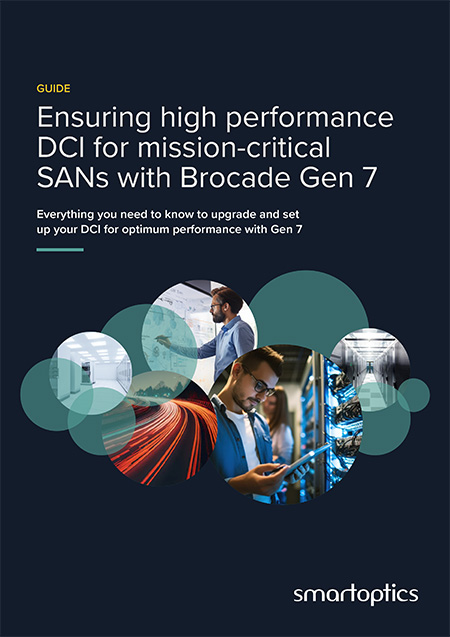Ensuring optimum DCI performance with Brocade Gen 7 using 32G FC
Your DCI may not have been the first thing on your mind when planning to upgrade to Brocade Gen 7. But it’s important not to forget the DWDM optics used with your Brocade switches for a number of reasons. For starters, Gen 7 won’t work with transceivers that aren’t certified, 16G optics are only supported in the X7 director and support is ended for 8G optics. Fortunately, there are also several more positive reasons to upgrade your DWDM optics along with Gen 7 that you should have in mind.

Did you know that Brocade Gen 7 will only work with certified transceivers?
With Gen 6 and past Brocade generations, you had a range of transceiver options. Transceivers from multiple brands were certified, and you could even still use compatible transceivers. This time around, your options are far more limited – but for good reason. To ensure only the best performance and keep downtime to a minimum, Brocade’s Gen 7 switches are designed to only work with certified transceivers supporting secure optics functionality. As a result, if you try to plug in any old transceiver that’s not certified, it probably won’t even be recognized by the Brocade switch or director.
Make the move to 32G FC easier with an active open line system
For the last couple Brocade generations, you could keep using the same old 8G FC optics. While this may have seemed convenient, Brocade is now nudging you into 16G and 32G FC by ending support for slower speeds with Gen 7. It’s just as well because these faster FC protocols offer many benefits. Nevertheless, this has important implications for your DWDM optics as you most likely will not be able to continue using your old solution.
First of all, your optics must be capable of supporting 32G FC ideally or at least 16G, but that’s not all. Moving to faster speed protocols also creates some new requirements that your old optics may not be able to handle. For instance, dispersion, which causes different wavelengths, or colors of light, to travel at different velocities in the fiber, can increase when deploying faster speeds with passive muxponder-based or amplified DWDM solutions. As a result, if you don’t resolve these issues, you may be missing out on the full performance benefits of Brocade Gen 7 in your DCI.
Also, you may not even be able to reach far enough to effectively interconnect all your data centers with your existing solution. Organizations with mission-critical workloads such as banks, retailers and governments could previously run their data center interconnect on 8G FC at distances of up to 80 km. But 32G FC will reach only around 8 km – unless you run the DWDM link on an active open line system with the proper amplification. The active open line system should also be easy to install and compensate for dispersion, which is crucial when you decide to migrate to higher bit rates.
More resilient mission-critical workloads and overall efficiency gains
Look on the bright side of having to upgrade your data center interconnect’s DWDM optics: you can benefit greatly from increased performance, efficiency and resiliency. Remember that your DCI plays a key role in securing mission-critical workloads by enabling synchronous mirroring. This means that improving its capacity will make your critical transaction and related data even more secure.
One of the selling points of Brocade Gen 7 is that it leverages autonomous SAN technology and advanced telemetry to provide far greater efficiency for your data center SAN. An active open line system does the same for your DCI. For instance, the latest open line systems provide automatic power balancing, automated dispersion compensation and full optical monitoring. This makes your DWDM network significantly easier to manage.
Future proof your DWDM links and create synergies
Another benefit of having to upgrade your DWDM optics is that you can get much more out of your investment. For instance, another interesting feature of next-generation open line systems is simultaneous support for 100G and 400G Ethernet alongside 32G FC. This enables you to create substantial synergies by using the same infrastructure for both Fibre Channel and Ethernet.
Smartoptics 32G FC transceivers and open line systems are uniquely approved for Brocade Gen 7
Brocade has so far only chosen to certify our Smartoptics 16G and 32G FC DWDM transceivers and complete open line system solutions for use with Gen 7 because of their great confidence in the reliability of our technology. With the Smartoptics DCP-M family of active open line systems, you can unlock the full potential of Brocade Gen 7 and 32G FC for your DCI. Thanks to embedded optics, you can just plug in and install our active open line system in place of your existing solution from almost any vendor, and it’s just as easy as configuring and implementing a passive line system. This way, you’ll enjoy all the benefits of automation, ease of use and support for 32G FC, 100G Ethernet and 400G Ethernet.
Download our guide for more in-depth information on ensuring optimum DCI performance with Gen 7.

Get the Brocade Gen 7 guide
Download the guide to get everything you need to know to upgrade and set up your DCI for optimum performance with Gen 7
Related articles

Why hundreds of enterprises with mission-critical workloads choose Smartoptics for Brocade networking

Four reasons to choose Smartoptics for Brocade SAN DCI
